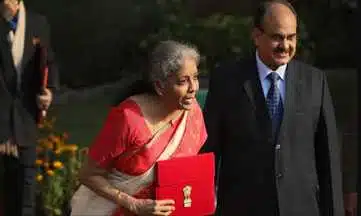Indian Finance Minister Nirmala Sitharaman will unveil the FY22-23 Union Budget on February 1, 2022. As we enter into the third – and hopefully final – year of COVID disruption, we expect India’s upcoming Budget will seek to balance short-term fiscal needs with structural reforms to support medium-term growth.
The Budget prospects going into the next fiscal year are relatively sunny. The past year has seen a strong recovery driven by private consumption and the release of pent-up demand. India’s nominal GDP grew significantly faster than expected, generating greater tax revenues to offset revenue losses elsewhere. Public investment, particularly on capital expenditures, also provided critical demand support as COVID-related uncertainty dragged down private investment.
However, the strong results over the past year were also partly the result of base effects and the recovery itself is still fragile, particularly as consumption reverts to normal levels and households look to rebuild their balance sheets. The omicron variant has also renewed economic uncertainty. Even without another full-scale lockdown substantial fiscal support will be required to keep the recovery on track. Charting the path forward is a challenge.
Given that backdrop, we expect the FY22-23 Budget to incorporate measures to boost welfare and generate growth in the short, medium, and long-terms.
First, we expect significant welfare spending to be the budget priority in the short-term. In light of the recent farmer protests, and statewide elections commencing in February, the government can take advantage of its strong revenue performance to continue important social supports. Subsidies for food and fertilizer have been a lifeline for vulnerable populations hit hardest by the pandemic and job guarantee schemes have played an important role in supporting domestic demand. These programs should continue as a necessary – albeit temporary –expenditure.
In addition, public spending on physical infrastructure to service secondary and tertiary care, integrating digital for primary and follow-up care and COVID-related medical interventions will rightly remain a top priority for the foreseeable future. Best practices have been built during COVID-19, particularly disease surveillance to enable early predictions and vaccine literacy to protect at-risk groups from various vaccine preventable diseases should be mainstreamed.
Second, we expect the finance minister will seek measures to boost the economy’s medium-term growth potential. Ideally, new measures will focus on promoting exports and domestic investment, to take advantage of structural changes in the global economy as real wages in other parts of Asia rise and trade and investment patterns shift. The Production Linked Incentives(PLIs) announced in the last budget were a positive step in this direction and should be expanded as much as possible in the coming year. The goal should be to unite “Make in India” with the demands of a shifting global supply chain and create the global manufacturing hub for labor-intensive, high value-added sectors that will deliver much needed employment.
Finally, to achieve sustainable long-term growth, the FY22-23 Budget must balance the competing needs of fiscal consolidation and large increases in capital spending. Finance Minister Sitharaman clearly recognizes macroeconomic stability is a prerequisite for long-term public investment, which in turn is necessary to crowd in the private and foreign investment needed to close India’s large infrastructure gap. The FY22-23 Budget is therefore likely to chart a path to fiscal deficits under 6 percent in the next two years, through a combination of expenditure discipline (for instance, no more fund for public bank recapitalization) and revenue enhancements (e.g. divestments and monetization of public assets).
The Budget will likely include an ambitious target for divestment revenues, possibly as high as Rs 1.5 trillion, or nearly three times the pre-pandemic targets. Though past experience in this area is not encouraging (actual divestments fell nearly Rs 2.5 trillion ($34 billion) short of the target over the past two years and the results of this year to date are no better), meeting an ambitious target in 2022 will be especially important. The economic benefit of a strong divestment program is indisputable, and the revenue generated is needed to pay for crucial social spending. The Budget is an opportunity to reaffirm the government’s commitment to divestment and outline a clear plan to sell at least 25 public sector units, including completing the huge IPO of Life Insurance Corporation (LIC) without delay.
Likewise, a strong focus on capital spending will raise the country’s growth potential and create jobs for millions of new employees every year. Research from the RBI shows that capital expenditures boost GDP growth more than any other category of public spending. The 25 percent increase in the capital spending budget last year was a great first step that should be matched by a similar increase this year.
Finally, we expect the forthcoming Budget will build upon recent efforts to strengthen India’s financial sector, the lifeblood of its economy. We look forward to new measures to broaden and deepen local capital markets and make it easier for investors to hedge the local currency.
A number of administrative reforms, such as easing restrictions on overseas listing of Indian start-ups and reducing regulatory burdens on Qualified Foreign Institutional Investors, would help Indian firms tap into global pools of capital. Other measures, such as reducing dominant role of government in banking and insurance markets though divestment and governance reforms, will make crucial financial services safer, cheaper, and more accessible to the vast majority of Indian citizens.
The FY22-23 Budget can also provide guidelines for eventual regulation of the fast-evolving crypto and digital asset space, a priority Minister Sitharaman touched on during her visit to the United States in late 2021. These measures will ensure consumer protection and financial stability without sacrificing innovation and growth.
With a focus on macroeconomic stability, fiscal discipline, revenue growth, and a shift from short term relief and medium-term recovery, the FY22-23 budget will chart India’s path back to sustainable growth and the pave the way towards a $5 trillion economy of its potential.
More Information
https://www.cnbctv18.com/finance/whats-in-store-for-budget-2022-short-term-relief-medium-term-growth-12296482.htm

